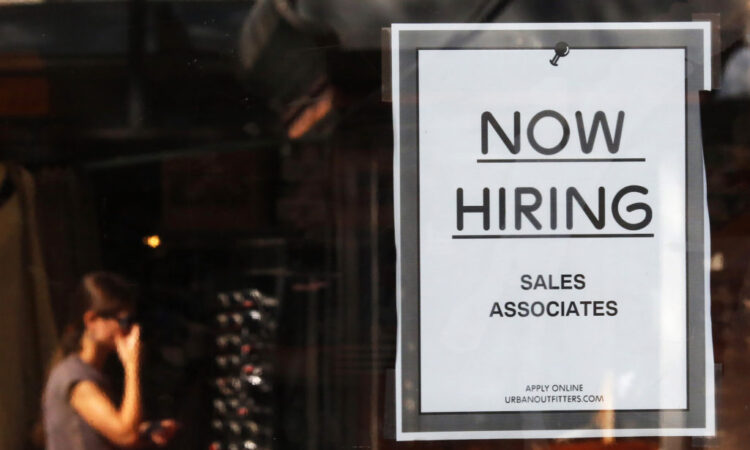
A “Now Hiring” sign hangs on the door to the Urban Outfitters store at Quincy Market in Boston, Massachusetts September 5, 2014. U.S. employers hired the fewest number of workers in eight months in August and more Americans gave up the hunt for jobs, providing a cautious Federal Reserve with more reasons to wait longer before raising interest rates. Nonfarm payrolls increased 142,000 last month after expanding by 212,000 in July, the Labor Department said on Friday. The jobless rate fell one-tenth of a percentage point to 6.1 percent, partly because people dropped out of the labor force. Photo by Brian Snyder/REUTERS
WASHINGTON (AP) — The nation’s employers pulled back on their hiring in April but still added a decent 175,000 jobs in a sign that persistently high interest rates may be starting to slow the robust U.S. job market.
Friday’s government report showed that last month’s hiring gain was down sharply from the blockbuster increase of 315,000 in March. And it was well below the 233,000 gain that economists had predicted for April.
Yet the moderation in the pace of hiring, along with a slowdown last month in wage growth, will likely be welcomed by the Federal Reserve, which has kept interest rates at a two-decade high to fight persistently elevated inflation.
WATCH NOW: Fed Chair Powell suggests taming inflation will take longer than expected
Hourly wages rose a less-than-expected 0.2 percent from March and 3.9 percent from a year earlier, the smallest annual gain since June 2021.
The Fed has been delaying any consideration of interest rate cuts until it gains more confidence that inflation is steadily slowing toward its target. Fed rate cuts would, over time, reduce the cost of mortgages, auto loans and other consumer and business borrowing.
Stock futures jumped Friday after the jobs report was released on hopes that rate cuts might now be more likely sometime in the coming months.
Even with the April hiring slowdown, last month’s job growth amounted to a solid increase, though it was the lowest monthly job growth since October. With the nation’s households continuing their steady spending, many employers have had to keep hiring to meet their customer demand.
The unemployment rate ticked up 3.9 percent — the 27th straight month in which it has remained below 4%, the longest such streak since the 1960s.
Last month’s hiring was led by healthcare companies, which added 56,000 jobs. Warehouse and transportation companies added 22,000 and retailers 20,000.
The state of the economy is weighing on voters’ minds as the November presidential campaign intensifies. Despite the strength of the job market, Americans remain generally exasperated by high prices, and many of them assign blame to President Joe Biden.
America’s job market has repeatedly proved more robust than almost anyone had predicted. When the Fed began aggressively raising rates two years ago to fight a punishing inflation surge, most economists expected the resulting jump in borrowing costs to cause a recession and drive unemployment to painfully high levels.
The Fed raised its benchmark rate 11 times from March 2022 to July 2023, taking it to the highest level since 2001. Inflation did steadily cool as it was supposed to — from a year-over-year peak of 9.1% in June 2022 to 3.5% in March.
Yet the resilient strength of the job market and the overall economy, fueled by steady consumer spending, has kept inflation persistently above the Fed’s 2% target.
The job market has been showing other signs of eventually slowing. This week, for example, the government reported that job openings fell in March to 8.5 million, the fewest in more than three years. Still, that is nevertheless a large number of vacancies: Before 2021, monthly job openings had never topped 8 million, a threshold they have now exceeded every month since March 2021.
On a month-over-month basis, consumer inflation hasn’t declined since October. The 3.5% year-over-year inflation rate for March was still running well above the Fed’s 2% target.
Left:
A “Now Hiring” sign hangs on the door to the Urban Outfitters store at Quincy Market in Boston, Massachusetts September 5, 2014. U.S. employers hired the fewest number of workers in eight months in August and more Americans gave up the hunt for jobs, providing a cautious Federal Reserve with more reasons to wait longer before raising interest rates. Nonfarm payrolls increased 142,000 last month after expanding by 212,000 in July, the Labor Department said on Friday. The jobless rate fell one-tenth of a percentage point to 6.1 percent, partly because people dropped out of the labor force. Photo by Brian Snyder/REUTERS






